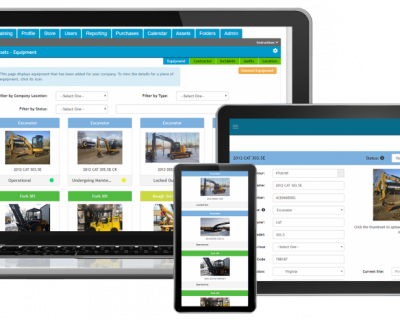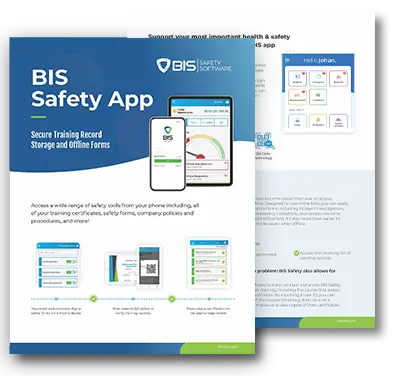
All You Need to Know About Equipment Inspection Records!
At first glance, equipment inspection records might not seem like a top priority of workplace safety. Some companies keep these records mainly because of federal or regional regulations, but that sells equipment inspection records short – they can actually bring more benefits than simply maintaining technical compliance. When done properly, equipment inspection records can help reduce workplace incidents, boost overall employee satisfaction, extend the equipment’s usefulness, and much more.
Explore this Article:
- Equipment Inspection Records: How They Work
- Why Equipment Inspection Records are So Important
- How Long Should Equipment Inspection Records Be Kept According to OSHA?
- Why More Companies Are Digitizing the Process with Equipment Inspection Software
- Equipment Inspection Records Are a Key Part of Workplace Safety
Equipment Inspection Records: How They Work
These records originate from the inspections themselves, whether it’s heavy machinery like cranes or backhoes, or personal protective equipment such as safety harnesses or gas masks. The primary goal of these inspections is to identify any problems that require repairs. Whether an issue is found or not, an equipment inspection form is completed to document the outcomes. If repairs are necessary, they are carried out, followed by another inspection with the hope of passing it successfully.
Traditionally, these records were kept in pen-and-paper format. However, like many business facets, equipment inspection records are increasingly transitioning to digital formats through equipment management software. Depending on which program you get, this software can do more than just store equipment inspection records; it can also track the equipment’s physical location, send scheduled maintenance reminders, and more.
Why Equipment Inspection Reports are So Important
Certainly, the foremost aspect to grasp about equipment inspection records is that they hold significance beyond mere formalities. Adopting this perspective allows us to transcend the realm of legal obligations and recognize the pivotal role these records play in ensuring workplace safety. In fact, they contribute significantly to addressing crucial safety concerns, making their maintenance imperative. Here’s an overview of the main benefits of keeping equipment inspection records:
- They make working conditions safer. Companies across all industries must prioritize regular maintenance of their tools and equipment. However, this commitment becomes even more critical when employees are engaged in tasks involving heavy machinery. So, where do inspection records come into play? A company that maintains thorough inspection records is more inclined to conduct regular equipment inspections. As a result, when workers are operating near moving machinery or electrical systems, the likelihood of jeopardizing their safety is significantly reduced.
- They forestall expensive repairs. In most instances, precise record-keeping is integral to a structured system – a system that proactively schedules maintenance instead of reacting to sudden issues that require immediate attention. Indeed, equipment inspection records often include the schedule for the next planned inspection, whether it’s based on months, miles, or some other unit of measurement. Staying vigilant and adhering to these deadlines can lead to substantial cost savings on repairs.
- They can prepare companies to replace their equipment. The breakdown of a costly piece of machinery can inflict financial strain, but this burden can be mitigated if inspection records have signaled that the equipment is nearing the end of its operational life. Perhaps it required increasingly frequent maintenance to remain operational, or a recurring issue persisted. Regardless of the circumstances, equipment inspection records can serve as an early warning to the company, indicating the need for a replacement in the near future.
- They can increase the equipment’s resale value. If you’ve ever purchased a used car, you’re familiar with the process. Buying used equipment offers certain advantages, but it also comes with the risk of acquiring something that’s been heavily used. However, equipment inspection records offer a complete record of repairs, replaced components, and information about potential equipment weaknesses. This provides prospective buyers with a clearer picture of what to anticipate, increasing the likelihood of the seller obtaining a fair price for their well-maintained equipment.

How Long Should Equipment Inspection Records Be Kept According to OSHA?
There are several categories of documentation that OSHA requires companies to keep on file, but equipment inspection records aren’t one of them. Even so, this doesn’t mean that they can be tossed whenever someone feels like cleaning out old files. These records could be important at a later date, such as:
- When proving that equipment was properly maintained in a worker’s comp case
- When demonstrating that best practices were observed in any other legal proceeding
It’s up to each company to determine how long to keep their equipment inspection records, but as a general rule of thumb, it should be at least as long as the equipment is in use – if not longer!
Why More Companies Are Digitizing the Process with Equipment Inspection Software
The inspection process initiates but concludes with documenting and storing the records. The crucial question is, how will you store these records? Historically, paper records were the preferred method. However, this also led to inspection forms getting lost in glove compartments or missing deadlines due to simple oversights.
On the other hand, equipment inspection software significantly streamlines the process. With software, you can effortlessly create checklists, monitor inspection progress, and maintain vital information like equipment location and status. This eliminates the need for manual processes, which are time-consuming and error-prone. By utilizing software, you can guarantee that all your inspections maintain consistency and accuracy, a critical aspect of ensuring the safety and proper condition of your equipment.
Using software for equipment inspections also offers the advantage of simplifying information sharing and collaboration. You can effortlessly distribute inspection reports and other crucial data among team members, promoting alignment and a shared focus on common objectives. This functionality proves particularly valuable for large organizations with numerous individuals engaged in the inspection process. Through software utilization, you can guarantee that everyone remains well-informed about the most recent information and collaborates efficiently.
Lastly, asset and equipment management software aids in maintaining a comprehensive record of your equipment’s history. This includes logging data from every inspection, as well as any maintenance or repairs conducted, resulting in a detailed equipment history. Such a history proves invaluable for verifying the proper functioning and optimal performance of your equipment. Moreover, it facilitates the tracking of long-term trends and the identification of areas requiring enhancement. In summary, the software serves as an incredibly valuable tool for equipment inspections, guaranteeing that your equipment remains in prime condition and operates at its peak efficiency.
Equipment Inspection Records Are a Key Part of Workplace Safety
In any industry, Workplace inspections of various kinds are crucial. However, performing an inspection holds value only if the data it produces is usable for learning. This emphasizes the pivotal role equipment inspection records serve in maintaining workplace safety. These records tell the history of each equipment piece, showcasing the company’s commitment to adhering to strict safety standards. When companies consistently repair, accurately record, and prioritize equipment maintenance with a focus on worker safety, they can enjoy the benefits of having comprehensive equipment inspection records across all industries.




































